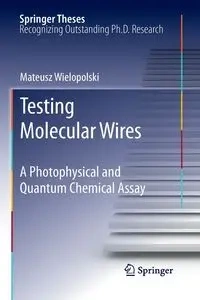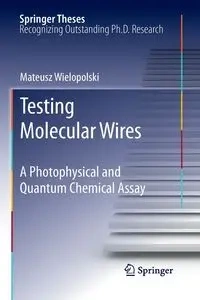Testing Molecular Wires - Mateusz Wielopolski
Testing Molecular Wires - Mateusz Wielopolski
- A Photophysical and Quantum Chemical Assay
AutorzyMateusz Wielopolski
EAN: 9783642265792
Marka
Symbol
897HGL03527KS
Rok wydania
2013
Strony
200
Oprawa
Miekka
Format
15.6x23.4cm
Język
angielski

Bez ryzyka
14 dni na łatwy zwrot

Szeroki asortyment
ponad milion pozycji

Niskie ceny i rabaty
nawet do 50% każdego dnia
Niepotwierdzona zakupem
Ocena: /5
Marka
Symbol
897HGL03527KS
Kod producenta
9783642265792
Rok wydania
2013
Strony
200
Oprawa
Miekka
Format
15.6x23.4cm
Język
angielski
Autorzy
Mateusz Wielopolski

I. Introduction and Motivation 1
1. Introduction to Molecular Electronics 2
1.1. Present Technology . . . . . . . . . . . . . . . . . . . . . . . . . . . . . . . . . . . 6
1.2. Limitations of Present Technology . . . . . . . . . . . . . . . . . . . . . . . . . . 7
2. Motivation - Focusing on Molecular Wires 9
II. Theoretical Concepts 11
3. Concepts of Photoinduced Electron and Energy Transfer Processes Across
Molecular Bridges 12
3.1. Introduction . . . . . . . . . . . . . . . . . . . . . . . . . . . . . . . . . . . . . . . 12
3.2. Electron TransferMechanisms . . . . . . . . . . . . . . . . . . . . . . . . . . . . 14
3.2.1. Superexchange . . . . . . . . . . . . . . . . . . . . . . . . . . . . . . . . . 17
3.2.2. Charge Hopping . . . . . . . . . . . . . . . . . . . . . . . . . . . . . . . . 22
3.2.3. Interplay ofMechanisms . . . . . . . . . . . . . . . . . . . . . . . . . . . 24
3.3. Electronic Energy Transfer . . . . . . . . . . . . . . . . . . . . . . . . . . . . . . . 25
3.3.1. Coulombic Energy Transfer . . . . . . . . . . . . . . . . . . . . . . . . . . 26
3.3.2. Exchange Energy Transfer . . . . . . . . . . . . . . . . . . . . . . . . . . . 27
4. Molecule-Assisted Transport of Charges and Energy Across Donor-Wire-
Acceptor Junctions 30
4.1. Mechanisms of Charge Transfer throughMolecularWires . . . . . . . . . . . . 32
4.1.1. Superexchange Charge Transfer inMolecularWires . . . . . . . . . . . . 33
4.1.2. Sequential Charge Transfer inMolecularWires . . . . . . . . . . . . . . 34
4.2. Factors that Determine the Charge TransferMechanism . . . . . . . . . . . . . 36
4.2.1. Electronic Coupling . . . . . . . . . . . . . . . . . . . . . . . . . . . . . . 36
4.2.2. EnergyMatching . . . . . . . . . . . . . . . . . . . . . . . . . . . . . . . . 37
4.3. Specific Aspects of Photoinduced Electron Transfer in Organic ?-conjugated
Systems . . . . . . . . . . . . . . . . . . . . . . . . . . . . . . . . . . . . . . . . . . 39
4.3.1. Background . . . . . . . . . . . . . . . . . .. . . . . . . . . . . . . . . . . 40
4.3.2. The ClassicalMarcus Theory . . . . . . . . . . . . . . . . . . . . . . . . . 41
4.3.3. Photoexcitation and Relaxation Processes in Solution . . . . . . . . . . 45
4.3.3.1. Photoabsorption . . . . . . . . . . . . . . . . . . . . . . . . . . . 45
4.3.3.2. The Franck Condon Principle and Radiative Transitions . . . . 49
4.3.3.3. The Franck Condon Principle and Radiationless Transitions . 52
4.3.3.4. Relaxation Processes Following Photoexcitation . . . . . . . . 55
4.3.3.5. Characterization by Stationary Spectroscopy . . . . . . . . . . 57
4.3.3.6. Characterization by Time-Resolved Spectroscopy . . . . . . . 58
4.3.3.7. Internal Conversion . . . . . . . . . . . . . . . . . . . . . . . . . 58
4.3.4. Influence of the Solvation on the Electronic Relaxation Dynamics . . . 59
4.3.4.1. Static Solvent Influence . . . . . . . . . . . . . . . . . . . . . . . 60
4.3.4.2. Dynamic Solvent Influence . . . . . . . . . . . . . . . . . . . . . 61
5. Examples of Molecular Wire Systems 63
5.1. Oligo(phenylenevinylene)s . . . . . . . . . . . . . . . . . . . . . . . . . . . . . . 64
5.2. Oligophenylenes . . . . . . . . . . . . . . . . . . . . . . . . . . . . . . . . . . . . 65
5.3. Oligo(thiophene) . . . . . . . . . . . . . . . . . . . . . . . . . . . . . . . . . . . . 67
5.4. PhotonicWires . . . . . . . . . . . . . . . . . . . . . . . . . . . . . . . . . . . . . 69
III.Results and Discussion 70
6. Objective 71
7. Instruments and Methods 79
7.1. Photophysics . . . . . . . . . . . . . . . . . . . . . . . . . . . . . . . . . . . . . . 79
7.1.1. Absorption spectroscopy . . . . . . . . . . . . . . . . . . . . . . . . . . . 79
7.1.2. Steady-state emission . . . . . . . . . . . . . . . . . . . . . . . . . . . . . 79
7.1.3. Time-resolved emission . . . . . . . . . . . . . . . . . . . . . . . . . . . . 79
7.1.4. Femtosecond transient absorption spectroscopy . . . . . . . . . . . . . 80
7.1.5. Nanosecond laser Flash Photolysis . . . . . . . . . . . . . .
EAN: 9783642265792
EAN: 9783642265792
Niepotwierdzona zakupem
Ocena: /5
Zapytaj o produkt
Niepotwierdzona zakupem
Ocena: /5
Napisz swoją opinię

